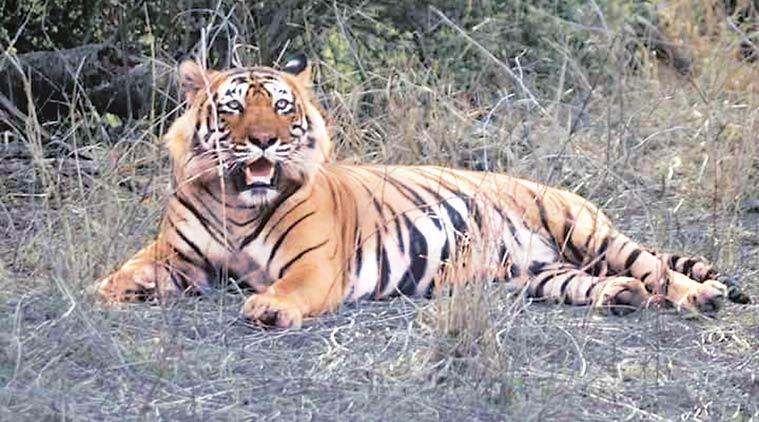 Experts oppose plan to shift Ustaad to a zoo, blame increased tiger
density, tourism for the attack. (Source: Express photo by Shruti Dua)
Experts oppose plan to shift Ustaad to a zoo, blame increased tiger
density, tourism for the attack. (Source: Express photo by Shruti Dua)
Jaipur |
Published on:May 16, 2015
Mahim Pratap Singh
The suspected reasons for escalating man-animal conflicts in Ranthambore National Park have left the Rajasthan government and wildlife experts divided over the fate of Ustaad, the tiger who mauled to death a forest guard in the reserve last week.
Barely a week after Ustaad, officially known as T-24, mauled the guard, another tigress attacked two onlookers photographing its cubs in the park on Thursday.
Experts say Ustaad is not a man-eater and by shifting him from Ranthambore to a zoo or a biological park, the forest department would be endangering his entire family — tigress Noor and two young cubs.
“There are two tigers at the corners of Ustaad’s territory. If he is shifted out, either of the two will move in and kill the tigress and cubs,” said Sunayan Sharma, former IFS officer. “Besides, by what logic is he being tagged as a man-eater? A man-eating tiger wouldn’t kill a person and walk away. I have never seen a tiger leave its kill behind.”
On Friday, Forest Minister Raj Kumar Rinwa told The Indian Express that a decision on Ustaad’s fate would be taken only after approval from Chief Minister Vasundhara Raje once she returned from Delhi.
“We have constituted a four-member committee to look into the matter. The names have been sent to the CM for approval. These experts will study Ustaad’s behavioural patterns and the history of man-animal conflicts within Ranthambore, and submit a report,” he said.
Following last week’s attack, the forest department was quick to tag Ustaad a man-eater, blaming it for killing three other people in the past. However, outraged wildlife experts and enthusiasts forced the government to defer the “decision” of shifting the tiger out of the park.
At the centre of the state’s latest big cat controversy are two questions: Is Ranthambore, with 64 big cats battling for territory over 390 sq km, too crowded? And if so, why aren’t some of the tigers being translocated to other sparsely populated reserves like Sariska or Mukundara Hills?
Most, including Forest Minister Rinwa, feel Ranthambore is saturated and conflicts between tigers and humans, and within tigers over territory and limited prey, were likely to escalate. “The region’s thriving tourism industry has been lobbying to prevent translocation of tigers from Ranthambore.
They do not want other reserves, primarily Sariska which is closer to Delhi, to develop as it would divert tourist traffic away from Ranthambore,” said Sharma, who is a part of Sariska foundation.
Shifting some big cats out from Ranthambore was also under consideration during the previous Congress government in the state.
source
The suspected reasons for escalating man-animal conflicts in Ranthambore National Park have left the Rajasthan government and wildlife experts divided over the fate of Ustaad, the tiger who mauled to death a forest guard in the reserve last week.
Barely a week after Ustaad, officially known as T-24, mauled the guard, another tigress attacked two onlookers photographing its cubs in the park on Thursday.
Experts say Ustaad is not a man-eater and by shifting him from Ranthambore to a zoo or a biological park, the forest department would be endangering his entire family — tigress Noor and two young cubs.
“There are two tigers at the corners of Ustaad’s territory. If he is shifted out, either of the two will move in and kill the tigress and cubs,” said Sunayan Sharma, former IFS officer. “Besides, by what logic is he being tagged as a man-eater? A man-eating tiger wouldn’t kill a person and walk away. I have never seen a tiger leave its kill behind.”
On Friday, Forest Minister Raj Kumar Rinwa told The Indian Express that a decision on Ustaad’s fate would be taken only after approval from Chief Minister Vasundhara Raje once she returned from Delhi.
“We have constituted a four-member committee to look into the matter. The names have been sent to the CM for approval. These experts will study Ustaad’s behavioural patterns and the history of man-animal conflicts within Ranthambore, and submit a report,” he said.
Following last week’s attack, the forest department was quick to tag Ustaad a man-eater, blaming it for killing three other people in the past. However, outraged wildlife experts and enthusiasts forced the government to defer the “decision” of shifting the tiger out of the park.
At the centre of the state’s latest big cat controversy are two questions: Is Ranthambore, with 64 big cats battling for territory over 390 sq km, too crowded? And if so, why aren’t some of the tigers being translocated to other sparsely populated reserves like Sariska or Mukundara Hills?
Most, including Forest Minister Rinwa, feel Ranthambore is saturated and conflicts between tigers and humans, and within tigers over territory and limited prey, were likely to escalate. “The region’s thriving tourism industry has been lobbying to prevent translocation of tigers from Ranthambore.
They do not want other reserves, primarily Sariska which is closer to Delhi, to develop as it would divert tourist traffic away from Ranthambore,” said Sharma, who is a part of Sariska foundation.
Shifting some big cats out from Ranthambore was also under consideration during the previous Congress government in the state.
source